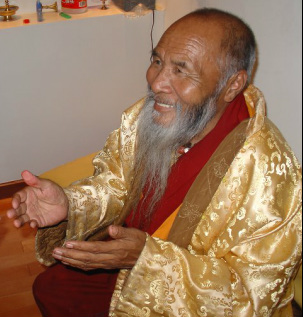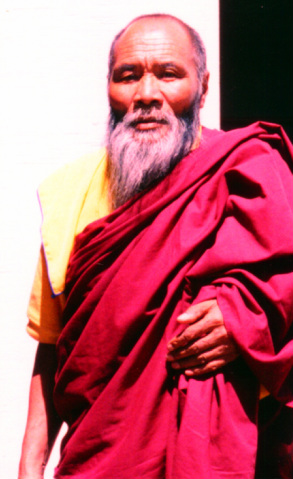|
Dudjom Rinpoche Video Media Print Media Dalai Lama Penor Rinpoche Video Media Gyatrul Rinpoche Video Media Print Media Yangthang Rinpoche Video Media Print Media Khenpo Jigphun Video Media Getse Rinpoche Tulku Sang Ngag Video Media Khenchen Namdröl Video Media Lobpön Nikula Kusum Lingpa Dodrubchen Rinpoche Chagdud Rinpoche Drugchen Rinpoche B. Alan Wallace |
His Holiness Penam Rinpoche (1925-2010)

Since childhood,
Ngawang Pedma Namgyal Palzangpo, H.H. Penam Rinpoche, was identified and
honored by many high lamas and tulkus as a highly enlightened being and
upholder of the Jonang doctrine and the Kalachakra Tantra. Penam Rinpoche received numerous instructions
and commentaries on the sutras, as well as numerous quintessential
instructions, transmissions, and the empowerments and commentaries for the Four
Tantras, especially the completion stage of the Kalachakra from Lama Monlam
Sangpo.
In 1997, H.H. Penam Rinpoche visited Tashi Chöling Retreat Center in Ashland, Oregon. He gave a Tröma empowerment and teaching. At the request of the Venerable Gyatrul Rinpoche he also gave spontaneous pith instructions to the assembly.
Some notes on the Jonang tradition: Among the early Tibetan masters of what later became the Jonang tradition was Yumo Mikyo Dorje, an 11th century yogi and student of the great Kashmiri scholar, Somanatha. Yumo Mikyo Dorje was the first to widely expound the teachings of the Zhentong view in Tibet. In the 13th century, Kunpang Tukje Tsondru established a main monastery at Jomonang in South Central Tibet, hence the name "Jonang". In the 14th century, Kunkhyen Dolpopa Sherab Gyaltsen wrote prolifically on Zhentong and the Kalachakra Tantra. Jetsun Taranatha later arranged the tantric practices of the Jonang and popularized the Zhentong teachings in Central Tibet. These teachings have become the core of the Jonang tradition as it survives today. The Jonang tradition is the only tradition of the five schools of the Tibetan Buddhist schools to uphold the Zhengtong Madhyamika. The Buddha proclaimed that "MInd is devoid of mind; for the nature of mind is clear light." Within the Madhyamika there are two main views: Rangtong and Zhentong. The Rangtong view focuses on the intrinsic emptiness of self and phenomena ("mind is devoid of mind"), while Zhentong is an expression of the non-existence of everything except the changeless, unstained enlightened mind, or buddha nature ("the nature of mind is clear light"). The great Rime lama Jamgon Kongtrul commented on the two systems: "Rangtong and Zhentong Madhyamika philosophies have no differences in realizing as sunyata all phenomena that we experience on the relative level. The have no differences also in reaching the meditative state where all extremes (ideas) completely dissolve. Their difference lies in the words they use to describe the dharmata. Zhentong describes the dharmata as 'ultimately real,' while Rangtong philosophers fear that if if is described that way people might understand it as the concept of 'soul,' or 'atman'. The Zhentong philosopher believes that there is a more serious possibility of misunderstanding in describing the enlightened state as 'unreal' and 'void'." The Jonang tradition is also recognized as being important in preserving the Kalachakra Completion Stage practice, also known as the Six Kalachakra Yogas. The Kalachakra Tantra is said to be a particularly important teaching during this time in human history, and for this reason His Holiness the Dalai Lama and other contemporary masters have granted the Kalachakra empowerment to large numbers of people. Although the Kalachakra Completion Stage practice has historically been transmitted through other Tibetan traditions, today the Jonang is its only source, and masters from other schools who teach the practice have received instructions through the Jonang lineage. Sources: http://www.rimebuddhism.com/tradition_jonang.html http://kalachakranet.org/kalachakra_tantra_jonang_history.html |
